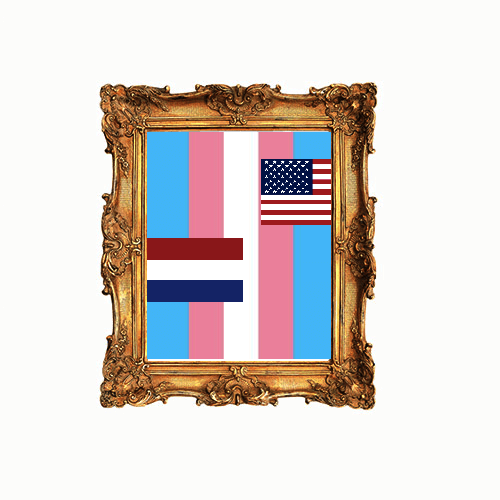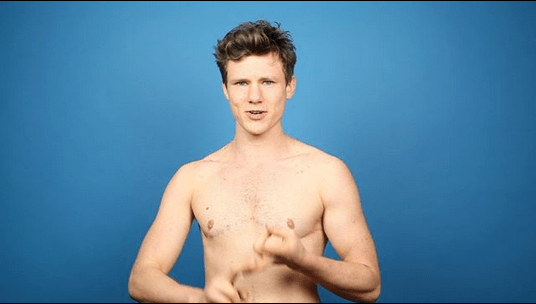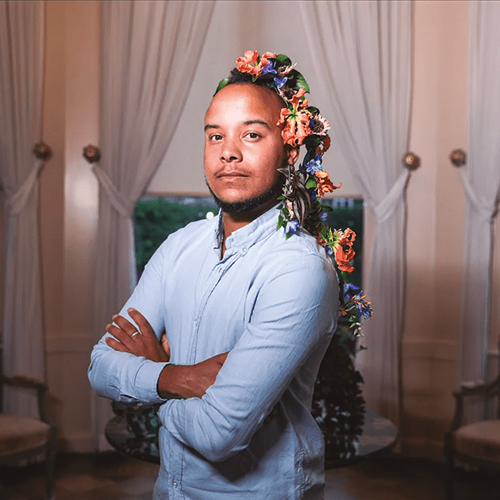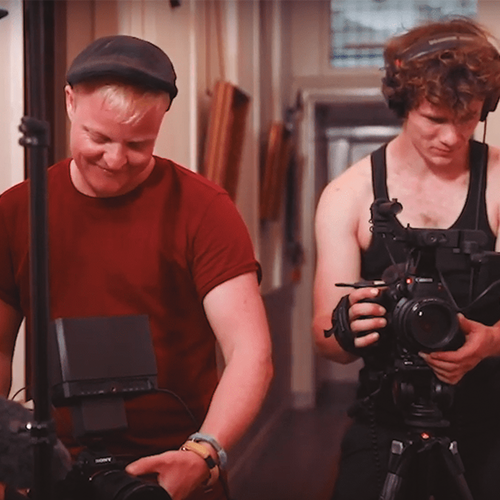
Transgender artists in the Netherlands
Chris Rijksen
In this (English) podcast, American queer art student Samantha White investigates the experiences of transgender artists in the Netherlands. The first conversation of this series is with Chris Rijksen, co-founder of the Transketeers and audiovisual artist in Amsterdam.
Listen to their conversation on Anchor.fm (47 minutes)

Chris, can you tell me a little bit about how you came to be a content producer? You do videos, you do podcasts, you do photography— how did you get started in all of that?
I am very much inclined to make things— I don’t know where that started. I remember that one of my first toys was a photo camera, and making music was already, from very early on, a thing from my parents and what I did as well. Doing theatre was something as well. I was very much encouraged. I had a lot of fun, always. And when I was choosing what to study, I was already photographing quite a bit, but I actually never considered going to art school because I thought, “Hmm. That’s not such a safe choice career-wise. And I don’t know what I will do and the path will be rather unclear…” and then I stopped, and I thought, “Okay— what if I don’t do it? Would I regret that? Would I regret not having tried, at least?” So— I tried it. And actually, I was photographing quite a lot and to everyone around me it was very obvious I should be doing something in regards to photography. But for myself, it wasn’t. And I got in at art school, at a good art school, and I was 17 years-old when I started it, so was really like, “Whoa, okay! Now I’m going to be an artist, now I’m going to be a photographer.” So I had this four years of photography, documentary photography education, and in the fourth year I was really out of love with the medium of photography, of still image, and I knew that music and theatre and live action and audio as well, were things immediate and really were attractive to me. But I did not know how to fit that in. So I studied two more years— I studied design. The education was called Dirty Art, which was like a “wink,” a “fat joke” to fine arts, and then you have ‘dirty art.’ In the last year of my Master’s, I started working with Bart. I knew him already from parties and from people I knew, but I knew he was a director and I knew that he did some impressive things. He crowdfunded a drama series. He premiered that in one of the biggest, oldest cinemas in Amsterdam. It was a beautiful story and well done. It was called Queer Amsterdam. It was all these characters who thought their identity was one thing, but then it got complicated because they were falling in love or they were finding out something new about themselves, so very much what we were all experiencing at 20 somethings.
I thought it was extremely cool, and I actually looked up to Bart quite a bit. But I also never really met him, and I never really spoke with him. Jonah was my friend already for some years then, and he really brought us three together. He really said like, “Okay, we need to be the three Transketeers, we need to do something together because there is now”— and it was especially within the Netherlands, and I think you can make the argument globally as well,— or in English language world— that around 2014-2015, there was quite a bit of momentum around stories about Transgender people, but not so much told by Transgender people themselves. So that was the thing where we really came together and said we really need to do this, because it’s nice that there is some attention but it’s like also, all three of us are educated to tell stories well— why don’t we do it ourselves? We don’t need the fancy television people, or the, “Hollywood known from another movie,” people. We can do it ourselves and ask much more interesting questions. It’s more authentic and it’s actually also something we missed. With the things that were created, we really missed that sort’ve depth in the content. And while I was working on my Master’s, we moved to film initially but then we really found out soon that it didn’t matter what kind of medium we were using. We could use presentations like live action presentations. We also produced with a bigger group of people a magazine, and we produced some interactive stuff, and some things that are only accessible online. So, we really are feeling quite free now, because it’s so clear what we want to do and we can adapt the medium to the thing we want to accomplish.
Do you feel like the work you’re doing is a kind of activism? Do you feel like it’s art separate from activism— is it intertwined?
I’ve spent a lot of thought on these questions also during my Master’s. I think the interesting thing we do with Transketeers is telling stories. And we do tell stories about people who experience struggle, who experience growth, or transformation in a way, which is mostly— in some one way or another linked to identity. What we are going to tell, what we’re not going to tell, how we’re going to frame it: there’s a strong idea behind all these choises…but that is not the point. The point is on the individual, the person we choose to tell the story. And if you can connect to the individual, then the biggest part of our job is done. Because that individual can open the door to think, “Whoa. I just saw a video about someone who identifies as gender-queer and I never really could fathom that those people exist.” So we use the people and the emotion and the connection as a vehicle, a sort of Trojan horse for other things.
Yeah, I think that’s one of the oldest kinds of story-telling and the most effective. Telling a story about a person and letting it contain themes that extend beyond them.
One of the things I’m always really trying to fit in is the complexity of people and that they are never one flat thing. For example, you hear someone say, “I am super masculine,” and then you see them dancing around pirouetting in the swimming pool. It’s not a punchline, it is to show that these things can co-exist. I truly belief in the plasticity of the brain and that of identity. That’s what I try to respond to.
Which project are you most proud of?
That’s such a hard question. I try to take myself seriously for about 10 years as a creator now, and I think you’re most in love with your current project. And then, if the current project is carrying on too long— which it mostly does— then your love flips over into loathing, and then if you’re done with it and you sort of forget about it then you look back, and you love it again. I think one project which I’m really proud of, is a project of three Trans guys. Because it’s a video project and the visual element is quite important here. It’s a series of portraits of Transgender guys who are talking about their facial hair. One has a massive beard. One has a great mustache, and the other one has a very pretty, well groomed beard.
This is Beard Stories you are talking about.
Indeed! We wanted to do something with the place of trans men in history, about which nothing can be found in Dutch history books. At the same time, we wanted to tell something about individuals who live this reality today.
And it had to be visually beautiful, a subtle play with elements which are considered to be masculine or feminine. We worked with photographer Prins de Vos. The setting of this video project is a seventeenth-century luxurious Amsterdam canal house with amazing colored rooms. At that time, the Dutch were, among other things, one of the largest flower traders around the world. This is how we came up with the idea of involving flower arranging artist Noortje Laan in the project.
We found three guys who were willing to tell their stories candidly. About how they chose to be themselves, how they had to deal with expectations (of themselves, but also of their parents and environment). And finally about the emotional balance, the strength they now feel.

There’s this perception in the US that the Netherlands is a place of perfect equality. Which, obviously is not true because that kind of idealized situation doesn’t exist anywhere. But especially for LBGTQ people, there’s this idea that all of the discrimination, all of the kind of barriers that, especially Trans people face in the US— they’re not present in Amsterdam. In the workplace, in the art world, for example. Can you speak a little bit to that? Do you feel that being Trans has made it harder for you to be an artist, or hard for you to be successful in Amsterdam? Or have you not experienced that?
Good question. Just… if I am walking into a gallery, or I am meeting some curator, or television person, or anyone, really. And I am here in my shirt and jeans, and maybe I have some nice shoes on, I am just a regular guy with a bit of a funky hairdo. And I don’t have to disclose that I’m Trans. I can also say I’m a documentary maker. I mean, if I am going to talk about my work I probably mention it in like, three seconds. But if I don’t, I talk about people and stories about identity.
In my experience, I am rarely directly rejected or discriminated against in a professional setting, when people discover that I am a trans man. Sometimes you do feel a certain distance, discomfort or incomprehension, or someone uses language in which a certain world view resounds where there is no place for me. That may be clumsiness and not unwillingness, but it is an obstacle that I have to deal with.
And I think there’s quite a bit of a difference if you talk about city and rural. In Amsterdam, people are like, “Okay whatever, I don’t really care. I don’t really blink twice if you look crazy.” I think I have it rather good here. I have this supportive family and girlfriend, I have my work which is going quite alright. I have a lot of things that are going for me. I have some friends who are status holders, like refugees, and then having their permission to stay here for five years, and then continue. Some people from Jamaica, others from Latin American, and… it’s quite a different story for them. They are coming here alone, they have no one to bounce back on, they don’t speak the language, they are not getting involved, they don’t find the kind of organizations like the Anti Discrimination Bureau quite so easily. So, you can feel much more alone if you’re there.
So what is your goal as an artist? Like, if you were to leave eventually the mortal realm, however you think that’s gonna go, what do you want to have accomplished with your art?
Every time people encounter my work, I would love them to find and open a new little door in their heads.
Now I am really working on the field of gender and I am trying to create space there, and make it possible for people to talk about gender also. “What is gender?” and we can broaden that to, “What is feminism?” “How does patriarchy keep everyone in check?” but also, “How does racism keep everyone in check?” “How does a restrained concept of identity is not always working for everyone?” I think questions are like door handles, most of the time. If you have the right question, you can enter a whole new space.
I think that’s the thing I really want to do, because I think there’s such an infinite amount of things to be thinking about, to be talking about, to be exploring, and if you can do that with love and curiosity, I think that life can be so rich, and I think that is one of the goals I pursue.
Thank you for sharing that, that was beautiful. Speaking of— going back to Transketeers, what do you and Bart Peters and Jonah Lamer have coming next? What can we look forward to from the Transketeers?
What we are working on right now and we’ve been working on quite for a long time is a show called ‘Sagen en mietjes’ (Sages en Sissies). It’s about the history of— it’s about the nonexistent history of queer people, or the untold history of queer people. And we’ve worked with some historians to look for examples in history, which if you take a look closer are quite certainly not heteronormative. And we want to parallel them with stories of today. We want to work internationally also. So we are working with a story about a Trans guy, or someone who presented as a man in the 1500s in the Netherlands and was kicked out of the military at some point because they exposed him as a woman. He had a big trial— that’s actually why we know all of this. And we try to, going to mix that with a contemporary story about Trans people in the army in the US.
Thank you so much for recording this with me and talking with me and everything you’ve share today, Chris.
Hopefully all listeners will join me in becoming a loyal follower of the Transketeers.

I am curious to know how similar or different the experiences for other trans women reading this have been. What have been the ups and downs of dating as trans women? Are you on this site? If yes, what has been your experience so far? Do you think these kinds of sites are helpful for trans persons? What about those who are more open to or have experiences outside the binaries? I am curious to read your stories. Please leave a comment below or contact us via info@transmagazine.nl.
